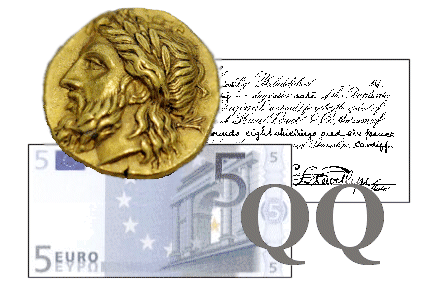|
Introduction
Financial markets, products, actors, and money
The objective of this course is to present world financial markets by types (foreign exchange, money markets, bonds, stocks, futures, derivatives), products and actors; to give a broad historical overview of their emergence; and to try
and foresee where they are going. We will also emphasize the nature and role of money, from its origins as precious metals to modern money, which is mostly pure recordings on paper and other supports.
Financial products are contracts involving the future, and are meaningful only within an organised society
We shall see that all financial products are contracts and promises, involving the future, between economic agents, and that they only have meaning and value within an organised society. If we receive a sack of rice for consumption we don't worry about any promise from other people. If we receive a pile of gold, depending upon what we intend to do with it we may or may not be concerned with its future purchasing power. If we receive $100 000 dollars, in bank notes or in US Treasury bonds, we shall be very concerned with their future purchasing power. The Chinese government is growing restless with such a concern. We shall try to view with fresh eyes a gold deposit receipt, and understand why and how such an abstract sign can play a role in the economic workings of society.
Financial versus physical investments
This course, though mostly concerned with financial investments, will also explain the difference between financial investments (where we acquire only promises, and we depend entirely upon other people's work and creation of wealth - a part of it going back to us by contract), and physical investments (where we acquire various capital goods, with the intention of exploiting them - plus some private advantages we enjoy - ourselves).
Various ways to sign a contract to acquire some goods
We shall study the differences between the various ways of acquiring a sack of rice:
1) receive today, and pay cash today (like you and I do in a store),
2) receive today, and pay in the future (like most stores do with their suppliers).
3) receive in the future, but pay cash today (as was often practiced in the XVth century and afterwards by merchants with home producers, a practice called by historians the "private market" as opposed to the "public market"), and
4) receive in the future, and pay in the future, but the contract is signed today, and the price to be paid is also agreed upon today (like is done every day on the so-called "futures markets"). Of course, one can imagine many more variations, including contract clauses introducing future random events; insurance policies are of this nature, and also most "derivative" (aka "exotic") financial products.
Tremendous evolutions since 1980
Since 1980, financial markets worldwide have undergone a rapid evolution due to two main causes: the Thatcher-Reagan liberal revolution, and the computer and internet revolution. They are still going through profound transformations with the rise of new world powers, trade flow changes, and the creation of yet more sophisticated financial contracts. The imbalances, of a commercial, financial and social nature, notably between the United States and the rest of the world, but also within many countries (high level of public debt, distribution of wealth more unequal than a generation ago, depletion of energy reserves), are likely causes of profound changes to come. In this course, we shall treat our technical subject in relation with the environment in which it takes place.
Society and exchange
Finance, payments, promises and contracts
Finance is the subfield of economics which looks at certain types of payment counterparts in exchanges, which are neither tangible goods nor money but only promises. This definition can be enlarged to a more general one:
Finance is the study of contracts linking two parties, which specify movements of cash between them now and in the future.
Future cash flows may depend upon certain conditions.
The framework of our study of finance will be "a society" (or "community"), that is a group of individuals, usually, but not always, defined
geographically. It may be
the whole world, a country, a region, a town, a family.
We
shall call "agents", individuals or groups of individuals viewed as a whole (for
instance, a firm, a bank, a city, a government, a trade-union, but also again,
a country, a region, a town, etc.)
Exchange and autarky
Economics is concerned with the creation of wealth and prosperity in a society, via production and
exchange. An agent which does not exchange with the rest of society is said to
function in autarky. Until the advent of the industrial revolution, which began
in England around the same time as the publication of "The Wealth of Nations" by
Adam Smith (1776), most rural communities in the western world - in fact
worldwide - lived in a high level of autarky. In medieval times, 90% of goods which were not simply auto-consumed were exchanged within 3 miles of their production, and 99% within 30 miles (cf. the works of Henri Pirenne or Fernand Braudel). Adam Smith
advocated free market, specialization and exchange. It is called
liberalism, or
laissez-faire. The debate on whether liberalism is the best social system to create wealth and a fair
distribution of it has a long history. After two centuries, loaded with dramatic events,
it is still going strong. It has two parts: one concerns the organization within
society. The other concerns exchanges with the rest of the world
outside the boundaries of society.
Why Adam Smith appeared at the end of the XVIIIth century
It is no coincidence if Adam Smith wrote the founding book of liberalism at the end of the XVIIIth
century. The world at the time
was undergoing tremendous evolutions. To understand them, one must go back to
the
Roman Empire, and recall the evolution of western societies
since that period.
From the beginning of the Christian era to about the end of the fourth century, most of Europe and the Mediterranean world were dominated by the Roman
Empire. The western part of it collapsed in the middle of the first millennium. From
the VIIIth until the XIth century, in parallel to the disintegration of the barbarian kingdoms which had replaced the Western Roman Empire, feudality became the dominant social structure
in western Europe, with the three orders: nobility, clergy and common
people.
After the year 1000, the relative peace following the end of the great invasions
fostered an important demographic, economic and cultural expansion. For instance, that's when we needed last names to distinguish each other.
It also
witnessed the emergence of incipient kingdom nation-states (France, England, Castile, and smaller states in the Holy Roman Empire).
Over the next six
centuries, these developed and gained strength until they had become absolute monarchies in the XVIIth
century, overcoming the alternative type of political system that had also sprung after the year 1000, independent city-states.
Meanwhile the development of international commerce, first by land and coastal navigation, and later, at the end of the XVth century, with ocean worthy vessels lead to the rise of a powerful merchant urban class, the first bourgeois, whose power came not from sheer strength but from money, that is signs.
A state with strong institutions has to come first, because money is a social contract. Indeed, why pay attention to a coin or a piece of paper, if we do not feel that we belong to a society with structures capable to enforce the value of the coin or the piece of paper? This bourgeois class was further enriched, relative to nobility, thanks to the great price revolution (c1500 - c1650), a long inflationary period - that is a readjustment of signs - during the course of which the average price of goods, but not of rents, was multiplied by five expressed in current monetary units. Its members supported ideas for a new more democratic social order and a new political and economic freedom, even though in truth they formed an oligarchy whose power had advented and which they were not ready to share. During the Enlightenment, these ideas thrived in intellectual circles and in books.
Adam Smith explained that freedom of exchange naturally lead to a stable state more prosperous than when hampered with barriers. Turgot thought likewise, and applied it with success to the commerce of grains in France. Necker who after Turgot got the charge of the French economy understood that the issue was more complex, but gave up too.
Adam Smith was a member of the clergy. His ideas were naive (see below) but in tune with the mind of the merchant class now in power. We are still, to this day, trying to understand why the liberal ideas of Adam Smith do not naturally match a fair society.
What happened next
The Enlightenment ended up with
the collapse of the monarchy in France, and in evolutions towards various
sorts of representative democracy all over the western world. The XIXth century
was the century of birth of western democracy, of many social revolutions, of
the emergence of social ideas (spurred by the industrial revolution), and the building of the opposition between the
advocates of a free system (political and economic) and those of a more directive centralised system. In the XXth century the opposition between the two systems,
plus a third fascist system (the first to try to apply socialist ideas by force), became violent, until the demise of the Soviet
empire, and at the very end of the century the economic rise of China. Now in
the first years of the XXIst century a severe financial crisis rocks the western
world, which may turn into a downright economic crisis leading to a new social,
economic, financial and monetary order of global scale. This course will attempt
to explain it.
Within society: laissez-faire versus government
Let's discuss briefly the two systems. As regards the organization within society, we have on one side supporters of liberalism who say that any other system is a "road to
serfdom", cf. Friedrich Hayek's most famous book, or Milton and Rose Friedman's
"Free to choose". On the other side, we have those who say that liberalism
produces serfdom too: some individuals are very rich and powerful (roughly 1% to 2% of the population, and they do not correspond to any illustration of the utopian dream of a society where social rank is justified by merit), while a large part of the people is maintained at or just above subsistence level. A strong and directive state, they say, "in the hands of the people", deciding to a large extent who should produce what and receive what, is a better system. Marx is the leading figure of this school of
thought, and China the last large country of earth where this political system can be seen at work. Hundreds of millions of Chinese workers still have their work and life conditions defined by the
hukou system which leaves them little freedom. Finally Keynes, in his book entitled "The General Theory of Employment,
Interest, and Money", published in 1936 at the height of the interwar economic depression, did point out some drawbacks of pure
liberalism too, like a society stuck in a suboptimal equilibrium. He recommended that the state, in some situations, substitute
for deficient markets, for instance launching public works, which would lead to higher employment and, via a
multiplier effect, induce a return to fully shared prosperity. Notice however that any investment, be it public or private, in that respect, has a "multiplier effect". This observation has often been made by people opposing Keynes's ideas; they say that the role of the State is rather to create the conditions that will induce private entreprises to invest.
With the rest of the world: laissez-faire versus protectionism
Concerning exchanges with the rest of the world, the question boils down to: Is
protectionism good or bad? We must be aware that most countries who officially
favor free-trade do use protectionism, more or less secretly, in some of their
economic sectors: for instance, the US in its cotton, textile and garment industries, Europe in its agricultural sector,
Japan in most of its industries, China, etc. And almost all the time in history, protectionism
has been the official policy of all nations. One example is the mercantilist thinking which guided European economic policies in the XVIIth century. Another example are the protectionist measures taken at the end of the
XIXth century to try and get out of the first modern economic depression (c.
1870 - c. 1890). In France it lead to the "tarifs Méline", in the US
to the protectionist
decisions of President William McKinley's administration. In 1930, at the beginning of the great depression of the interwar period in the XXth century, the United States passed another protectionist law called the Smoot-Hawley tariff act which is responsible for the important slowdown of world commerce in the 30's.
The importance of the possibility of partial autarky
It is the view of the teacher that a measure of protectionism, and the possibility to resort to partial autarky, are good,
modulated according to circumstances. Pure liberalism says that economic freedom is the best way
for everyone to have access to the best goods at the best price, to enjoy negotiating power and to be encouraged to do whatever is "optimal" for him or her. For example, a worker who wants to sell his work
(i.e. be hired), if he is unhappy with the salary offered him "can
always go elsewhere". But this
is a theoretical view that does not correspond to the reality of markets. Often
people have little choice, but accept, or organize and rebel - or live in partial autarky. Similarly, to see social communities destroyed by
delocalization or imports - be they cheaper than local productions - calls for other answers than just say: "Well, they will have to do something else."
To the best of our knowledge, the relative negotiating strength of the two parties in an exchange (like Skype being sold to eBay for 3 billion dollars, though Skype at the time of the sale was very young, very small, and only in the red) has never been satisfactorily addressed by current theories.
Those who do address the problem (like Marxism) are more political opinions than logical proofs, and they are still fraught with judeo-christian underpinnings.
Economics of a family
Observe that smaller economic agents which it is not customary to
analyze economically do use autarky all the time. For instance in a family,
many of the chores are done within the family that could be purchased -
presumably "at a better cost" - outside (doing the dishes, mowing the lawn,
fixing the plumbing, building the shed, etc.). And within a family it is not the laissez-faire laissez-aller which produces the best results in terms of development and prosperity. It is rather some sort of "guided freedom".
Protectionism produces unexpected effects
Protectionism may also have unexpected positive economic effects aside from protecting local productions and markets. It is protectionist measures, encouraged by English wool producers in early XVIIIth century, that lead to the development of a local cotton industry, to replace Indian imports, and to the mechanization of some of its operations.
Surprisingly, this unleashed no less than the industrial revolution and the advent of the modern world (see Pietra Rivoli, "The Travels of a T-Shirt in the Global Economy", Wiley, 2006). The Multifiber Agreements, which organized world textile commerce since the 1960's, also lead, in unexpected ways, to the industrialization and the economic
development of several Third world countries.

Claude le Lorrain, Seaport at sunset, XVIIth century
Why economics has made so little progress
So far economic theory has made little progress in clarifying which economic
system is best. Beneath a veneer of scientific arguments, the debates are most often emotional and political (remember that > 80% of human "reasoning"
is in fact emotional). This has lead to dubbing economics "the dismal science"
(Thomas Carlyle). One of the reasons for this failure is the
complexity of the problems. Compared to economic problems, the theory of
dynamics is simple: in the appropriate setting, you write f = mx'', and then
with some developments of this equation, found by Isaac Newton around 1665, you can describe very precisely the movement of a body over a long period of time! Even the theory of relativity or quantum mechanics are "simpler" and
stunningly precise to describe real phenomena. Their models depart radically
from our usual experience of the world (or, what would be more accurate, from our commonly used models, which we are most of the time not even aware of), and they are themselves full of interesting and
deep problems, but they "work well". Not so economics.
Economic phenomena are not evolutions toward equilibriums. Classical mathematics are inadequate to treat economic problems
Economics developed in the wake of the Age of
Enlightenment and of the path breaking work of Adam
Smith. One of its leaders, in the XIXth century, was Léon Walras
who tried to carry over to the economic field the achievements of dynamics and
thermodynamics in the physical field. This was, from the outset, a misguided
intuition: it searched desperately for equilibriums, and tried to use
the mathematical tools at hand. Mathematics turned out to be a limiting
constraint too. They were, and still are, mostly "linear", in the sense that a variation in
the variable x yields a simple and easily computable variation in the function y = f(x).
As a consequence, the results obtained in the XIXth and XXth centuries (Ricardo's
theory of comparative advantage, Heckscher Ohlin Samuelson developments,
game theory of von Neumann and Morgenstern, Sonnenschein Debreu Mantel theorem, etc.) may be mathematically
sophisticated but, in truth, have little relevance to understand and pilot the
economic and social world we live in.
Smith's views are naive and mistaken
Many people are still fascinated by Smith's famous sentence "It is not from the benevolence of the butcher, the brewer, or the baker, that we expect our dinner, but from their regard to their own self-interest. We address ourselves, not to their humanity but to their self-love, and never talk to them of our own necessities but of their advantages" and his concept of "invisible hand" that is supposed to drive the economic system to an optimum. It is still the cornerstone of basic liberalism. But this idea, however attractive to common sense, is to be set aside on the same shelf of old mistaken ideas where lies Aristotle's claim that heavier bodies fall faster than lighter ones. Both are wrong. Aristotle's statement was easy to invalidate (although it took humankind twenty centuries to do so, and you may check that most people around you still think that heavier bodies fall faster - even in a space void of air), whereas Smith's is more difficult: one must construct computer models of society, production and exchange, and study them with no preconceived ideas (see R. Axtell & J. Epstein, 1996 or Dessalles, Galam & Phan, 2006). It pertains to the field of complex dynamic systems, the behaviors of which are quite different from what common sense suggests. We only begin to be able to do so (see below, the conclusion of this subchapter).
The application of Ricardo's ideas lead to food riots
The obstinate application of Ricardo's and other liberal principles by the world bank and the IMF (the so-called "Washington consensus") to African countries lead to economies depending on a small number of agricultural products (coffee, cotton, wood) or basic extracted products (oil, mineral ores), which had to be imperatively exchanged on international markets, and which in turn made these countries highly vulnerable to world prices volatility. Now the IMF is at last
changing its views and beginning to advocate diversification, even if it is into "uncompetitive" sectors like subsistence agriculture, and is "tolerating" tariffs if it is for a good cause (for populations to be able to eat).
In other words, the economists at the IMF finally realized that the economy of a family is not an oddity but a natural organisation, that should also apply to larger entities like countries. For the amateur of etymological justifications, the word "economy" comes from the Greek words οἶκος (home) and νόμος (organisation, rule). At the end of his career, Paul Samuelson, who built it on using thermodynamics ideas as a searchlight for equilibriums in economics, who received the highest distinctions from its peers for that, and who was a life long fan of Ricardo's ideas, began to admit
that perhaps these were wrong-headed.

Food riots consequences of staunch free trade, early 2008
Sophisticated mathematical finance is useful for short term speculation, but useless to understand long term financial and monetary evolutions
Mathematical finance rests on a branch of mathematics called stochastic calculus which is a bit more complicated than ordinary calculus. Some "financial gurus" hide behind them to explain to the hoi polloi that it cannot understand economics because it is too sophisticated for it. Among the gurus of the past were Irving Fisher (the fellow who, in the days preceding the krach of October 1929, declared that "Stock prices have reached a permanently high plateau"), Markowitz, Merton, Rubinstein, etc. In his book "A History of the Theory of Investments", Wiley, 2006, Rubinstein, reviewing the practice of Buffett (a very successful investor disdaining modern financial theory), writes on page 70 "It is hard to argue with success..." and goes on to find plenty of faults with Buffett. Universities, since their inception eight centuries ago, have displayed a kind of self-generated sclerosis, which was made fun of at different times by many talented writers. In certain circumstances, the models of finance resting on stochastic calculus work well in the very short term: they can predict likely evolution of prices and enable their users to make money from that; it is essentially arbitrage. But they never work in the long term because, being blind to social, political and other events, the probabilistic models fail to map real phenomena. This is why the capital asset pricing model (CAPM) is of limited interest, and the careful analysis of 80 year long time series of data from Wall Street ludicrous. This is also why the theories of Merton and Scholes applied to the management of LTCM lead that hedge fund, gambling on Russian bonds price movements, to lose four billion dollars for its owners and for the banks that were requested to bail it out. All banks have a department of mathematical finance. They speculate using sophisticated
tools. They also gamble sometimes taking risks they know they ought not to take. When the outcome is happy, they are discreet about their ways and means, and prefer to let it be thought that "they are very well managed by super intelligent people". But when they go into the wall, like Société Générale in January 2008 which lost 5 billion euros on unhedged positions on the Dax, they try to make the gullible believe "it is the fault of some low ranking employee who was able to gamble 50 billion euros without the upper management being aware of it". A similar mishap, though on a smaller scale, happened to the Barings bank a few years ago, in its Singapore branch. The top executives in England expressed the very strong preference for the lawsuit, involving their employee at fault, to take place in Singapore rather than in London.
The ambition of the course
You may be interested in mathematical finance to become a golden boy or girl, in high demand in London, New York or Paris, to make heaps of money as a trader of securities and derivatives, or as a quant predicting short term movements of prices using fancy techniques. But the objective of this course is more ambitious: it is to understand the likely evolution of the world financial and monetary system over the next generation, and to foresee what new world we are preparing for ourselves and our children. This does not mean that we will shun mathematics entirely. But we will put them in their right place, along with many other historical, social and political analytical tools.
Complex dynamic systems will bring new insights
To finish this critical review of economic science on a positive note, let us mention that there are new hopes of building, at last, useful models. Until recently phenomena like deterministic chaos
or emergence were beyond the reach of formal science. But over the last twenty years studies of "complex dynamic systems" have been able to make significant
progress, thanks to new modeling possibilities offered by powerful
computers. Economic phenomena are highly complex and dynamic by nature, and will
be better understood with these new tools than with models of the past.
Here are two experiments modelling real phenomena where randomness plays an important role, but the formal status of which, in term of complexity, are quite different:
- balls falling through a mesh of nails: the experiment can be computer-generated to see what's happening. But in this example classical mathematical analysis can grasp, describe and explain precisely the phenomenon. Any distribution of balls in the lanes is possible, but the very large majority of them are approximately bell-shaped like the coefficients of the binomial. It is a result in numbering.
- termites transporting wood: in this example, where termites randomly pick, transport and unload chunks of wood, according to some simple rules, we can observe a fascinating accumulation of wood into a few number of piles, and eventually only one. But here classical mathematical analysis is powerless to predict precisely the final lay out. We can study, however, what's happening by looking at many computer-generated simulations (this example comes from MIT's modelling software starlogo).
Most interesting economic problems pertain to the field of complex dynamic systems.
The science of government lags fifty years behind.
Most interesting problems in economics, finance and the theory of money belong to the second category.
Investigations into what government actions on what levers, within what structure of institutions and legal
framework, will create more prosperity as well as more social justice, require such studies and take us far
away from what common sense suggests, like the dismal hand of Smith. But political leaders will continue for a
while to try and apply methods which will seem outrageous fifty years from now,
like creating more government agencies to fight unemployment
or, conversely, like the first solutions employed to try and get out of the great depression of the 1930's
which only aggravated the situation: applying a tight monetary policy. Indeed it is what the ECB staunchly
maintains in the first half of 2008. But in fact the ECB has no alternative. It was not founded to participate in the
far-sighted and bold creation of the monetary systems of the future, but only to manage the euro (itself
a rather ambitious achievement, one must recognize). J.C. Trichet is essentially powerless in front of
the present financial and monetary turmoils rocking the planet. He is like a physician in 1650 who had
only two options at his disposal to cure a patient in bad shape: bloodletting and herb infusions.
Medical science figured out in the XVIIIth, XIXth, and XXth centuries that this was far from enough.
It understood the function of organs, complex abstract structures like the immune system, or the role
of DNA and genes. The ECB right now alternates injecting huge amounts of money in the system
(hundred of billions of euros) to help private financial institutions avoid bankruptcy, raising
interest rates to thwart inflation (in part resulting from the first action), and fine tuning
banking regulations (akin to the precise dosage of herbs by Diafoirus). Economics still has a
long way to go. As has often been the case in the past, it is the markets which will introduce
the really revolutionary financial and monetary techniques of the future (to which
securitization does not belong, see lesson 5).
The likely emergence of new private international currencies, and the slow demise of nation states
One of the theses of this finance course is that an entirely new private worldwide financial and monetary system is likely to emerge in the coming years. Financial institutions free from most regulations and issuing receipts (i.e. something equivalent to money, see below) already exist; they are called hedge funds (details in lesson 7). But so far they focus on making as much profit as possible rather than on guaranteeing the stability of the purchasing power of their liabilities. And their accounts are still denominated in official currencies, whereas we think that the future financial system will use new currencies on the model of the - for the present - anecdotic Linden dollar or QQ. The new monetary means will not be created and introduced as a large scale official event, like the switch to the euro in January 2002 (a rather stunning feat, one once again must recognize), and hawked in marketing campaigns on radio and television and other foremost medias, like for instance the new search engine cuil, in the Summer of 2008, which was loudly presented as the revolutionary engine "better than google", "destined to replace it quickly", and was forgotten as quickly as a bad movie is forgotten, but will ooze slowly throughout the whole world economic system. And when we realise that many exchanges are done with a new "token" money, this money will have existed already for many years. As we shall stress several times in this course, most monetary and financial innovations emerged slowly and spontaneously and had been around for a long time before people realized they were cornerstones of the economic system. This was the case of bills of exchange and of banknotes for instance.
The need for a better grasp of elementary complex dynamic systems
The next step for this new science will be to go beyond simulations and to begin to classify complex systems, just as has been done with functions during the XVIIth and XVIIIth centuries (polynomials, homographic functions, trigonometric functions, functions defined by series, etc.). Then it will be easier to study various legal frameworks, rules of exchange, government, and money management to build a satisfactory society.
What models may be able to represent
Elaborate models may be able to show "in vitro" the rise of powers within a society, something substantially different from what is taught in civics classes. Powers, i.e. groups of individuals exerting influence to their advantage, emerge spontaneously too, and dynamic equilibriums among them are reached. The town hall of a big city, even though it holds the legal power, must deal (i.e. transact) with other powers, for instance trade-unions to make the municipal services function (see for example how Le Havre was unblocked by its present mayor when he was first elected in 1995). It must deal with various other lobbies and powers, including illegal ones: in Marseille the mayor cannot be elected without the Corsican mafia's assistance, in exchange of which organized crime enjoys city hall's tolerance regarding games, girls and rackets. Similarly, the freemason movement originated in medieval times in Europe from elevated ideas about how society ought to be organised and function, but all too often nowadays it consists only in networks of cronies helping each other in ways contradictory with the spirit of democracy. Democratic systems are an ideal type, which can only function temporarily before clientelism, the emergence of lobbies of all sorts, and other wearing out processes corrupt them. Probably grassroots politics in America in the late XVIIIth century was the best real life application of the democratic ideal. It is our view that now, nowhere in the world can it be seen at work. It is one of the reasons of the weakness of the West to combat the other social systems (totalitarian societies, Islamic societies, theocracies, etc.) which threaten it.
One more note on the 2008 crisis: no real wealth has been destroyed, yet.
The 2008 worldwide financial crisis burst in the Summer of 2007 with the so-called "subprime crisis" (too much lending by American banks to home borrowers, who turned out not to be able to repay according to schedule their loans, when the price of their houses stopped increasing, and at the same time the monthly payments they had to make increased; and the banks had resold, "repackaged", the loans to financial institutions all over the world; about $2000 billion of these financial assets today are worthless), a crisis which spilled over the whole world. But, as of 12 October 2008, one must notice that no real wealth, no machine, no tool has been destroyed and the work forces all over the world are here today, as they were yesterday. The crisis is financial and monetary in the sense that it concerns only signs: signs of ownerships, and signs of liabilities. The tangle of signs of ownerships and liabilities that is a part of the representation of a society was under too much tension, and went awry. Now it is contributing to stop the "real economy", that is to send not only banks but industrial and commercial firms into bankruptcy, and therefore stop production of goods and services. The West is entering into a recession. There was a belief that "the free-market" could autoregulate itself, and that prosperity for everyone is the stable state of such a free-market, two ideas which are obviously wrong. It is the whole system of signs, the last grand construction of which dates from Bretton Woods, that has to be profoundly revamped. As this course purports to explain, it will be mostly spontaneously done by players outside the control of states and with new private currencies.
In this course, we shall focus on finance and money: two fundamental concepts structuring exchanges in a society, and also pillars of nation-states. We are engaged, at the beginning of the XXIst century, in a process than will probably see, by the end of the century, the end of nation-states as we have known them for the past two hundred years.
These questions may seem academic, yet they are quite real. They
concern, very concretely, our lives as individuals and as communities for the
coming years.
What is a financial
product?
A transaction
To understand what is a financial product, we must go back to the basic exchange, that is to a transaction between two agents
A and B.
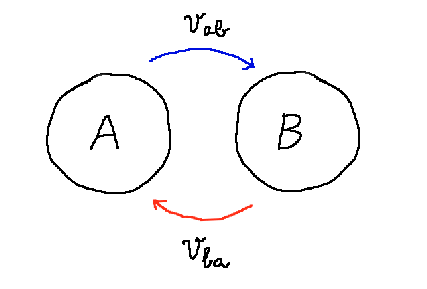
There are two fundamental situations concerning time:
- Either, the transaction is completed right away, "closed" now, at a time which we shall denote t. Nothing else has to take place in the future.
- Or, at time t, A gives B a real value Vab, but the value Vba given by B to A is only a promise to give A a real value later on, say at time T.
The second situation is typically the case when A gives $1000 to B now; and B gives now to A a promise to pay him $1050 in one year, that is a basic 1 year 5% bond.
There are many variations on the basic example of a transaction involving two dates, t and T.
For example, at time t, A and B may exchange neither tangible values nor money, but only sign a contract to exchange some things at date T under conditions specified at t.
The three types of value circulating between A and B
So we see that we have to consider several types of "values" going from A to B, and from B to A, namely:
- Tangible value: for instance, a sack of rice, a car, a machine-tool, a violin, a house, an
English lesson, an airplane ticket, etc.
- Money
- A promise to give something, usually tangible value or money, in the future
And we have to consider one or several dates in time:
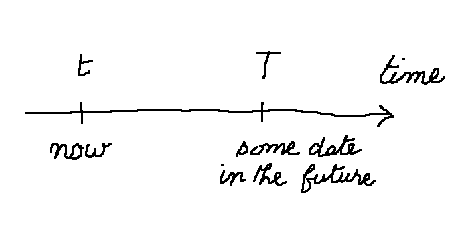
Throughout this course, unless specified otherwise, t will represent "today" and T a date "in the future"
Of course, there are transactions where what will happen in the future involves a sequence of dates, for instance years. In that case, "now" is usually denoted t0, and the future years, t1, t2, t3, etc.
Discrete or continuous time model
A note about the modelling of time in finance:
- sometimes the time model we use is discrete: the only possible dates are "today", "in one year", "in two years", etc.
- sometimes the time model is more realistic and continuous. Any date in the future can be considered: "today", "in three month", "in 24 hours", "in ten years", etc.
In a first approach, the discrete model is simpler to manipulate. In that case, the shortest time period is one year. And the shortest term bond is a one year bond. In more advanced financial calculations, for instance using stochastic calculus, the continuous time model turns out to be simpler to manipulate. In this course, according to the context, the reader will know if we refer to a discrete or a continuous time model, or if the distinction is not relevant.
We are now in a position to define what is a financial product:
A financial product is, in a transaction, a transfer from one agent to the other, which is neither tangible value, nor money, but only the third case of transfer: a promise of something in the future.
A more general and abstract definition is the following: a financial product is a contract between two agents, specifying present and future cash flows between them. The present cash flow may be null, and the future cash flows may depend upon various conditions, and be random.
Among financial products are:
- bonds
- insurance contracts
- stocks
- options
- swaps
- etc.
The fundamental financial product is the bond
The fundamental product falling into this definition is a bond: i.e. a contract signed by B, and handed to A, to make a series of payments to A, in the future, according to a schedule specified now.
Shares of stock are included in this definition too.
Contrary to bonds, they are not contracts specifying only future payments, they are rights of ownership over a part of a firm. But, in that respect, they give right to future dividend payments and to votes.
For shares, the situation is not black and white between tangible value and financial product. When we buy one share, representing the ownership of a small percentage of a firm, it is only a financial product. But when we buy 100% of the shares of a firm, it is akin to buying tangible value. In between, it depends the percentages, and the rights granted to us.
What is tangible value
In our approach to finance, tangible value is what can be consumed. Money is not tangible value, financial products are not tangible value. An apple is tangible value, a car is tangible value, a two week vacation in a hotel resort is tangible value. The difference can at times be a bit blurry: the right to occupy a flat for one month is tangible value; the ownership of 25% of a firm is usually considered a financial product.
Financial products are traded
Once it has been created, by B to pay A, the financial product Vba becomes an economic good. It is called a financial security. Finance views it as something that was bought by A from B, and for which A paid B with Vab transferred from A to B. Now, and until the contract it represents expires, Vba can have an economic life on its own. It can be traded. A, who owns it, can sell it, at some later date t' between t and the expiry date, to somebody else, for example C. The price at which A can sell Vba to C will depend upon economic conditions at the time of sale t'. It does not have to be, and usually is not, the initial price A paid B for it.
At time t, when it was created by B to pay A, we say that Vba was issued on the primary (financial) market. When, it is exchanged again, at a later time t', between A and C, we say that Vba is traded on the secondary market.
Some preliminary thoughts and questions about money:
Link between the present and the future
We saw that a financial product is a very special type of economic product which links the present and the future. Typically, at date t, today, an investor lends something (usually money) to a borrower. And the borrower promises to refund the investor at date T, which is a specified date in the future. The borrower, at date t, gives the investor a piece of paper (or the equivalent) on which he has written "I owe you xxx + some specified interests" (where xxx stands for what was lent). The question is "how to measure what was lent at time t, and the value refunded at time T?" Most usually it is done with the help of money. But money is a more elusive concept than appears (see subchapter below).
Money and purchasing power
Obviously, in theory, the investor wants to get back its money (leaving aside interest, which is an extra payment for the service of lending). But more precisely the investor wants to get back its purchasing power. This is not exactly the same idea, because the purchasing power of money can change between t and T.
Money is an abstract unit of measure of value
Money is only an abstract unit of measurement of value (see below). One euro is nothing material in particular. It is the value of various things at date t, and of various other things at date T. The coin of 1€ is just the material representation of the right to buy something worth 1€. What is worth 1€ is another story. Is it one of the roles of monetary authorities to make sure that most things worth one euro at date t are still worth one euro at date T? Or is it nobody's role?
The Gold standard era
Why use money if it is so unreliable? In the XIXth century, developed countries tried to make currencies very reliable by linking them to gold. It was called the gold standard period, which lasted from around 1870 until 1914, and then in another form, from 1944 until 1971. And until a few decades ago, there was no alternative to money to "fluidify" exchanges. At the beginning of the XXIst century, with the present power of computers and telecommunications, it can no longer be said that money, as it has existed for thirty centuries, is still necessary.
The power of nation states rests in part on their money
We will see that money is closely linked to centralised nation-states, social structures which emerged worldwide over the past four or five centuries. The decreasing importance of official currencies will parallel the decreasing power of nation-states. Then, of course, the future is likely to be bewildering, with the emergence of new powers, distinct from nation-states, "supra-national", and able to offer more reliable means of exchange, akin to money, than present days nation-states (like the United States, Japan, China, or the countries forming the Euro zone).
But let's first of all study money and financial products as they exist in our present world made of nation-states.
Net present values and personal values
Monetary measurements
In economics, finance and accounting, the value of things is measured in monetary terms, using the official currency of the society under study, or some other currency.
To stay simple, in a given community, where the official currency is the euro, a transaction between A and B will be two transfers: Vab from A to B, and Vba from B to A. And the values, expressed in euros, of the two things transferred in each direction will be the same. This can be written:
Value in euro of Vab = Value in euro of Vba
Official values and personal values
This is what the standard theories in economics, finance and accounting say. But it is only a part of the story. Obviously, if A gives away Vab to receive Vba, it is because he prefers Vba to Vab. And conversely for B: he prefers Vab to Vba.
Accounting of personal values
In fact accounting does represent this fact in certain cases. For example, when a firm sells a product from its stocks, the selling price of the product is higher than its value recorded in the stocks (using the FIFO or some other methods of evaluation of stocks).
This is indeed the rationale for the at first sight strange looking technique of recording a
sale in credit in a sales account. If the values of the thing and the payment were
the same, we could just credit a stock account and debit a payment account. But
since the value for the firm (stocks) and the value for the client (sale) are
not the same, a sale of something leaving stocks is recorded as a "double
transaction". There are two ways to account for this: either the technique of a Purchases account, adjusted, at the end of the accounting period, for stocks variation; or a real time stock monitoring system. Both methods are absolutely equivalent. If we use the second one, the two transactions go like this:
- transaction 1: debit a payment account and credit sales
- transaction 2: credit a stock account and debit the COGS
Then, in the income statement the difference between the
sales and the COGS, and some other costs, yields the profit.
Physical versus financial investments
When we consider an investment made by A - that is, A spends some money to acquire some things that will not be quickly consumed, but will be used to produce value over a long period of time - you will remember from your Introductory finance course, that there are two cases:
- Physical investment. Definition: there are interferences between the acquisition and the other activities of the buyer
- Financial investment. Definition: there are no interference between the acquisition and the other activities of the buyer
In a physical investment, A acquires tangible goods (lands, buildings, machines, etc.) and intends to operate them in order to create wealth and therefore values. In that case accounting reckons that the value-to-A of what he acquires may be higher than the price he pays for them at acquisition time. By this we mean that the calculations of the present value of all the future cash flows, which A expects to be able to produce with his acquisitions, yield a higher figure than the price he pays today. In algebraic notation, if C0 is the price A pays today, and C1, C2, C3, ... Cn are the future cash flows, which A expects to produce, we have (with PV standing for "present value"):
C0 < PV(C1) + PV(C2) + PV(C3) + ... + PV(Cn)
Discounted Cash Flow Analysis
The calculations of the present values are carried out using the usual discounting formulas, which we shall review shortly. In this case, we say that the Net Present Value of the investment made by A is positive.
The origin of positive NPV
How come A can buy from B something that is worth more than the price B charges to A? The crux of the matter is that A will be able to combine his
acquisitions with his present assets, or know-how, or personal advantage, to produce value in a way that the seller B could not. In other words, when we say "the goods traded have such and such value...", we have to be careful: "To whom?" The value-to-B and the value-to-A are not the same.
Arm wrestling contest
A consequence of these differences in "personal values" is that a transaction becomes an "arm wrestling contest": A tries to figure out what's the value-to-B of what he plans to sell him; and B tries to figures out what's the value-to-A of what he plans to acquire from him. For instance, let's consider the owners of Skype (A) and eBay (B), in September 2005. The value-to-B of Skype was very high. With Skype, eBay estimated that it would be able to develop much more rapidly, and therefore the cash flows produced by eBay+Skype were anticipated to be way higher than those of eBay without Skype. After proper discounting, the present value of these delta cash flows (i.e. difference between the cash flows with Skype and the cash flows without) were still in the billions of dollars park. The value of Skype to its owners was not very high. They had created the firm three years before, its 2004 turnover was $7 million, and it had always been in the red. So the negotiating range was, in theory, between $0 and several billion dollars. Skype owners were skilled enough to sell their firm to eBay for $2.6 billion.
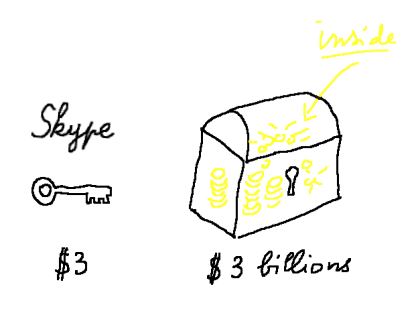
Skype is a key to a treasure trunk for eBay
As you may remember from your Introductory finance course with the teacher, the most telling image to explain how eBay could pay such a sum, is that of a key to a trunk containing a treasury: the fact that the manufacturing price of the key is about $3 is irrelevant. What matters is what's in the trunk. (Another more technical comment: obviously, with $3 billion anyone can reproduce the specific precious know-how of Skype, so in fact eBay was essentially buying a 3 year
head start, because in certain development projects time is incompressible, no matter how much money one pours into the project.)
Negotiating power
Similarly, when someone has a low qualification, is unemployed and lives in a region where only one employer recruits, his
negotiating power is rather thin, and he will be forced to accept a low pay. This is one of the reasons why, as of early 2008, in France, aside from the officially 2 million people unemployed (in reality more like 4 or 5), between 5 and 10 million people hold very precarious jobs. Of course, pure liberalism says things like: "They can move to another region. They can start their own firm. Such an idle work force is a great potential wealth for the nation, they can produce all sorts of riches, etc." Usually, people who make this kind of comments have no experience whatsoever of what it is to be crushed economically and socially by the system, and would probably not be able to apply their "recommendations" to themselves, should they experience such difficulties.
In a financial investment, things are simpler
Within its models, Modern Financial Theory establishes that: "NPV's are always zero." Despite its apparent paradoxical aspect, when one thinks of it, this statement makes sense: in a financial investment we buy something that has no interference with our other assets, activities or private possibilities. In that case, the delta future cash flows for the buyer are just the future cash flows of the acquisition. The buyer and seller view the same cash flows and have therefore the same personal evaluations of the security or entity traded. The price paid by the buyer will be exactly the value of the future cash flows. Whence NPV = 0.
Not everyone considers Modern Financial Theory (MFT), the standard mathematical financial theory taught in business schools, relevant
Warren Buffett has always explained that he considers MFT a useless theory to understand financial markets and make good investments. He gave a famous lecture on this topic at Columbia University in 1984. Warren Buffett was a student of Benjamin Graham, the founder of the school of "value investment". And Graham and its followers have, for most of them, been very successful investors, which must say something about the pertinence of their theories. These are a mix of common sense and extremely attentive monitoring of markets and firms: in short, according to Graham and his followers, markets are not efficient, on the contrary they are always irrational, the prices of firms are sometimes too high (bubble phenomena), sometimes too low (irrational depression). One only has to wait until the price a firm is too low, compared to some "intrinsic value" calculated with the usual discounting formulas on future expected cash flows, and invest in that firm. It is also possible to sell short when the price of a firm is too high (expecting a coming downturn), but it is more risky.
Money
Let's go back to our transaction between A and B, and suppose, by convention, that it is A who sells some goods G to B, and B who pays A with some value V. (This is entirely conventional, to make the subsequent
reasoning easier to follow, since a transaction is an exchange of values, and we could as well say that A buys V from B and pays with G.) In other words we replace the notations used above by : G = Vab and V = Vba (cf. picture above).
In Accounting, the two legs of a transaction are measured as having the same monetary value
We saw that, from an accounting point of view, in a normal transaction, the monetary values of G and V are equal. And, for example, in the accounting system of A, the sales account is credited this value, and another account (cash, client, or other) is debited the same value.
There are three ways for B to pay A with value V:
- V can be some tangible goods with the same monetary value as G. An asset account of A will then be debited. Such a transaction is called barter. It is unusual in modern trade between firms.
- V can be a promise (that is some financial security) from B. If this financial security is simply a promise to pay with some delay (for example, in 45 days), the client account of A will be debited.
- V can be money (in the form of cash or a cheque). In this case the cash or bank accounts of A will be debited.
Barter is bygone, or is it?
In the markets of developed countries, barter is a technique belonging to a distant past, when the monetary system was not elaborate, and it is no longer in use. Notice, however, that in international trade it is still sometimes used by countries, which have raw materials like oil or mineral ore, to import goods from rich countries, but are "cash tight". Sometimes the rich countries as well prefer such payments to currencies or financial securities the value of which may be volatile.
What is money
We shall concentrate on what is exactly the nature of the money with which B pays A in the third case above. As we know from our Introductory course in accounting and finance, money can be cash (coins and bank notes) or a cheque drawn on B's sight bank account.
The traditional description of money goes back to Aristotle
He said that money has three functions:
- it is a measurement of value, like when I say "this watch costs 150 euros". In this case, I don't refer to anything concrete, I just assign a number (a measurement, a "value") to an object; usually, more precisely, it is the market which assigns a value to this watch, or even simply enough some people I intend to deal with who accept this value.
- it is a means of payment: if I owe you 40 euros, I can give you, in theory, anything that costs 40 euros and my debt to you is extinguished. In such an exchange, what I give can be, in theory, an object that has the "value" 40 euros (in the sense of point nr 1), usually provided it is easy to sell again (that is, it is "liquid"); I can also give you two 20 euro bank notes, which are some sort of "receipts" of value by the State itself, and are legal tender.
- it is a reserve of wealth: I keep a stash of anything (objects easily tradable, fixed assets, bank notes, or gold coins, under my mattress, or in a bank account) to preserve the "value I own".
The important distinction between "money" and other valuable belongings
The important distinction between "money" and other valuable belongings is that money can easily participate into the movements of business (exchanges of goods and services between people), while other valuables cannot as easily. When I have 1000 euros in bank notes in my pocket, I can use them for exchanges of goods (for my consumption or investment on my part), but I can also use them to purchase financial titles (i.e. lend or give this money to somebody else); in that second case I can no longer participate as easily in exchanges of real things whereas the person who received my money now can. These commonplace ideas are yet to be transformed into an efficient theory of money which can explain the impact of money, its origin, its management by private people and public authorities, on the prosperity (and fair sharing of wealth) of a society. Despite the efforts of numerous brilliant minds since the XVIIth century (Petty, Cantillon, Law, Smith, Ricardo, Tooke, Wiksell, Hicks, Friedman, and many more), such a theory still needs to be created.
It is a profound mistake to view money as something concrete (like a pile of gold coins) that can be accumulated, and that can enter or flee countries
It is the view of the teacher, in particular, that it is a profound mistake to view money as something concrete (like a pile of gold coins). Or at least, it is a severely limiting conception. Money is a set of signs (even the ownership of gold is only a sign of something else: the capacity to acquire something valuable, in the sense of "that can be consumed, or that can help produce consumables"). It is a set of signs of rights and liabilities between various agents in society. In a society with only one agent (just one person), money has no use, no meaning. The "value of money" depends on other people acceptation of these signs. To accumulate money means only to accumulate signs recognised by other people. They can always change their mind, and in that case the money we had accumulated becomes worthless. (Something different from accumulation of goods!) This happened to the Russian bonds; it is in the process of happening to American bonds; it will happen to the French bonds the government plans to issue in mid-2009 (a rather "pragmatic" way to help society to exchange again : issue bonds, with the implicit understanding that they will be worthless in a few years...)
In its role as a unit of value, money is a rather abstract concept
For example, one pound sterling is no particular material element. It can be the price of various things, at some date, but these things may see their price, expressed in pound sterling, change over time. This can be caused by inflation, deflation, technological progress, or an evolution of their rarity, etc. At any rate, one pound sterling is only an abstract measure of value. Similarly, what does a 100€ bank note buy ? Answer: anything costing now 100€. But what costs 100€ ? Answer: that's another entirely different question? And what will cost 100€ ten years from now? Ans: that's yet another question?
The confusion between unit of value, and its material representation
From Antiquity until relatively recently (a few decades), each unit of currency was also represented by a certain quantity of material substances, like precious metals, in the form of coins or otherwise. This has been the source of endless confusion and complications about money, first of all because it has always been very difficult to make sure that these material representations kept their official value. And secondly it made, for centuries, people think that money is something material, that must be somewhere, and can be hoarded, when in fact it is just a certain type of contract involving the future. For more than a hundred generations men, who had never heard of a bank, thought that the best way to keep one's savings was in the form of gold and silver coins hidden somewhere in their home. Many people still think like that today.
The confusion about money and value endures: the example of Norway
For instance, in the XXIst century, following a similar misunderstanding of money, Norway keeps pumping with platforms planted in its Ekofisk field, like a straw in a big soda, oil from the bottom of the North sea, sells it, and stashes dollar denominated Treasury bonds, and shares of stocks, in order to "make reserves for the future". Actually, even aside any monetary considerations, the best saving by far would be to leave the unneeded oil under the sea. It is true though that the international community, which accepted in the 1960's that Norway own a third of the North sea, would not let it keep its oil in the ground. In France many people's grand parents financed the transsiberian railway, and they know what the liabilities they received were worth.
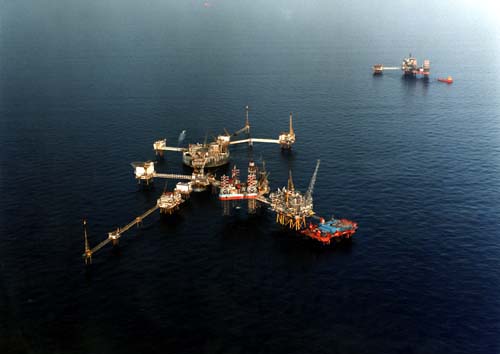
A platform in the Ekofisk oil field
But, to understand money, let us begin with describing ancient coins made of precious metals and their long evolution.
The beginnings of money in Antiquity
According to Herodotus, the first people to have used minted coins of precious metals (gold, silver, and various alloys) in the western world were the Lydians, around 700 bc. Lydia was a region corresponding to the western part of modern Turkey. The last king of Lydia was Croesus (560-546 bc), before the
Persian conquest by Cyrus the Great in 547 bc. A lively account of this story, and of the emergence of money, can be found in Peter L. Bernstein, "The Power of Gold", John Wiley, 2000, chapter 2.
Substances which have served as money
A great number of other substances, in history, have been used as money, in various regions, at various epochs, including sea shells named cowries, in use for a long time around the Pacific ocean, salt, cattle heads, beads, feathers, wampum, axes, cigarettes, etc. Cattle heads is the origin of the word "capital" used in an economic context. In this financial course, we shall concentrate on the emergence of modern money, which evolved from metallic money.
Gold
Gold became a precious metal, just about everywhere in the world, because of its chemical and physical characteristics: it is chemically very stable; it does not become oxidized or combine easily with other substances; it has a pleasant yellow shine; it is very malleable and therefore easy to work; it is relatively rare and difficult to extract, etc. Until the end of the middle ages the most important mines were in Nubia (present day northern Sudan). In ancient
Egyptian, "Nub" meant "gold". The English word "gold" itself derives from "gelo", which also gave "yellow". The Romans inherited gold mines in southern Spain when they won the
Punic wars against Carthage.
Introducing signs of value on objects incorporating themselves value
At first, metal coins bore signs specifying their value, that is the weight of precious metal in them. But people using them would weigh them anyway, and also check the quality of the metal using a touchstone. Pure gold is called 24 carat gold. The first metal based monetary systems used several metals: most often gold, silver, copper and bronze. In Antiquity, the ratio of value of gold to silver was most often maintained by official authorities at 10:1, that is 1 ounce of gold has the same value as 10 ounces of silver. (Gold is customarily weighed using the Troy ounce which is 31.1034768 grammes.) Considering that gold coins had a rather high value (several months of earnings of a simple person), this bimetallism was necessary to be able to have coins of reasonable sizes for smaller amounts of value.
The fundamental evolution of money from matter to sign
Beginning in Antiquity, monarchs began to impose that the value of coins be the sign on them and not the actual weight of gold they were made of. This is a fundamental evolution of money from matter to sign which has great advantages
as well as severe drawbacks.
Money was not used by everyone in the population until recently
Before going further, we must stress that in Antiquity coins, and more generally money, was not commonly used by everybody. It was mostly used by kings, princes and big merchants. Little by little money pervaded populations, thanks for instance to the Romans paying their soldiers in part with money. But for most of the times, until at least the XVIIIth century, money was not something commonly and daily used by everyone. The
generalization of the use of money is a feature of modern times, during the last two centuries.
Advantages and drawbacks of the evolution of money from matter to sign
The evolution of money from matter to signs had, we said, great advantages and severe drawbacks. An economic system needs monetary means (money) to function. Yet it is unclear what is the relationship between the money supply and the economic activity during any given time period [t1, t2], for instance one year. The concept of velocity of money is dubious (John Hicks called the relationship PQ = MV a tautology rather than an equation), it implicitely rests on the idea that money is a quantity, an old Christian concept which comes from the fundamentally accumulative-minded orientation of these people. At a time when monetary means were chronically scarce, to be able to produce new means at will was an advantage. The drawbacks were that princes and counterfeiters could produce coins with less precious metal than their sign (also called "face value") indicated. It is the process called debasement. History has recorded that Roman emperors, beginning with Nero (37 - 68), but also Philippe le Bel (1268 - 1314) of France, or Henry VIII (1491 - 1547) of England, were great debasers of their money. There are many more.
Facilitating money creation. Fuelling inflation.
On the advantage side, such a process once again allows the monarch to create more money with the same quantity of metal. It also helped him have money at a time when the fiscal system was not efficient. And, as said, commerce needs money. Therefore, in certain circumstances, an increase in the money supply (via debasement or using, we shall see, purely fiduciary money) helps the development of commerce. But in others it
disorganizes the economy and creates inflation. These comments belong to the subject of monetary policy: how to guarantee the "value of money" when it does not have intrinsic value, how to avoid inflation, how to fight economic depression, what are the links between the financial and monetary sphere and the real sphere, what are the factors to economic prosperity, which are still very important today, and that we shall have ample opportunity to return to. The Bullionist controversy in England, following the Napoleonic wars, belongs to this debate. The ill advised return for the pound to the gold standard exchange rate prior to WWI, by Churchill, then Chancellor of the Exchequer, in 1925, belongs to it too.
The problem of monetary means which are signs at the same time as they incorporate themselves value. The further difficulties brought by bimetallism.
There is yet another drawback when the process of going from matter to sign is only halfway: the fact that gold coins are made of gold, a precious metal with a market price (in fact market prices in various regions of the world), and, similarly, silver coins are made of metal silver, and coins bear signs of official values which generally do not correspond to the market value of the metal in them, leads to all sorts of monetary dysfunctionings. For instance when considering a bimetallic monetary system, there are at least 4 figures to take into account. To stay simple, let's take the example of the pound sterling (the abstract unit of the English monetary system); the four figures to heed are:
- the quantity of gold in a coin worth one pound sterling
- the quantity of gold worth one pound sterling
- the quantity of silver in a coin worth one shilling
- the quantity of silver worth one shilling
Where Newton shows up again
If the market value of the gold metal in a gold coin, officially worth say one pound, is less than the market value of the silver metal in the 20 coins of one shilling one can buy with the gold coin (ratio in force until 1971, when England switched to a metric monetary system) a traffic springs up: people convert their gold coins into shillings, melt them into silver metal, buy gold metal, have it coined, and find themselves with more money than before - and do it again. The main gold coin in England, in the XVIIIth century, was the guinea, the value of which was set by Isaac Newton, after 1717, to 21 shillings. And one ounce of gold, of 11/12th purity, was set to be worth £3 17 shillings and 10½ pence - a ratio in force until 1931, with only two interruptions of convertibility (1797 to 1821 and 1914 to 1925). After his life as a scientist, Newton had become the master of the mint in London in 1699. This value of 21 shillings, set by Newton, was too high, and some people consider that it is the reason why England went into a gold standard - because, according to Gresham's law, "bad money drives out good", therefore people kept silver coins and used gold coins in their payments.
Switching radically to signs
So money underwent an evolution from precious matter to sign, but until around the XIIth century in the western world, its support remained metallic coins. Then appeared a radical evolution: the very early beginnings of paper money in the West. Some money was reduced down strictly to signs on the simplest things able to bear signs: bits of paper. China had invented a type of paper money in the IXth century and it used it for several centuries. It fascinated Marco Polo who spent time in China during the Yuan dynasty (1271 - 1368). But the subsequent Ming dynasty (1368 - 1644) went back to an entirely metallic money. It is a very interesting story, but independent from the emergence of paper money in the West.
A contract is a sign
A sign on a piece of paper, or, better, a piece of paper with a sign on it showing some value, is nothing more than a contract entitling the bearer to receive the shown value in exchange from the piece of paper. In the case of paper issued by a merchant (for instance, a bill of exchange) to pay for something to a seller, the paper the seller receives is a private contract between the buyer and the seller. In the case of modern bank notes, we shall see that it is a public contract between the bearer and, in a sense, the whole society.
European prosperity: 1000 - 1300
After the year 1000 and the last barbarian invasions (Lombards in the VIth century, Normans in the IXth and Xth
centuries), Europe began to enjoy a period of relative peace, and of great
demographic, economic, social and cultural expansion, which lasted until the
Great plague of 1347-1350 that killed approximately 1/3 of the populations
between Turkey and Ireland. The same population count, as in 1300, was only
reached again after two hundred and fifty years, in 1550!
Pope or kings
The epoch built cathedrals, founded universities, launched unfortunately crusades too (the first of which was preached a couple hundred yards from ESC-Clermont). In the wake of the fall of the
western part of the roman empire, its replacement by barbarians states (founded by the Franks, Burgundians, Goths, Angles, Danes, Saxons, etc.), and the confrontations with the Arabs, the Turks and the Mongols, incipient national powers appeared in France, England, and Spain. The history of Europe between the XIth and the XIVth century is also a chronicle of the struggle between spiritual and temporal powers (the pope and the church versus kings and the emperor of the holy roman empire) to dominate the western world.
The rise of Lombard cities
An important episode, among many others, is the battle of Legnano, in May 1176, which opposed the Lombard League of cities of northern Italy to emperor Frederick Barbarossa. The cities won, and this marks the beginning of the emergence of Genoa and Venice as dominant economic powers in the West in the XIIIth century.
The invention of double-entry accounting
Merchants from northern Italy are credited with the invention of double-entry accounting. In 1494, Franciscan friar Luca Pacioli (c 1445– c 1515) published "Summa de arithmetica, geometria, proportioni et proportionalita" which contains the first modern treaty of accounting. Subsequent enrichments, including the recent International Financial Reporting Standards (IFRS), haven't added much. And, in fact, in 2008, it is being considered to abandon some IFRS "improvements" because they contributed to the aggravation of the subprime crisis (banks having to depreciate some financial assets as soon as they are traded anywhere below recorded value).
The IFRS "improvements"
The IFRS "improvements" came from the fanciful idea that the total assets of a firm ought to add up somehow to the value of the firm, or at any rate that each item ought to be recorded at its "true" value (presumably its "market" value). Such naive thinking can still be seen in the term "net worth" (= total assets - external liabilities). That some assets are recorded at their market value is more or less true of the liquid part of them, but certainly not of the fixed assets. So it was recommended to evaluate the financial assets at their market value. (With a startling lack of logic, it was not recommended to record also the inventory at its market value... - because of course it would corrupt the entire mechanism of double-entry accounting, which consists in recording profit only when it is actually made via a sale ; and even then, if the sale is on credit, the recorded profit is only provisional.) Generally speaking one must understand that the value of a firm is not the sum of its assets. If it is a financial investment (defined as a standalone investment, that is an investment which will have no impact on the other activities of the acquirer), it is the discounted value of all its future cash flows (a definition which doesn't help much !). And if it is a physical investment (defined as an investment which will have an impact on the acquirer's activities), it is the discounted value of all the future extra cash flows for the acquirer.
From God, Man and Nature, to nominalist thinking. Economics is still fraught with pre-nominalist ideas.
In the late middle ages, it is the Franciscans who made great contributions to western thought (Bacon, Ockham, etc. who were Nominalists), and the Dominicans who thwarted progress (Inquisition, Thomas Aquinas, etc.) Among other feats Thomas Aquinas (1225-1274) is the medieval scholar who "explained" that things have a natural price, related to their cost, thereby planting confusion for centuries in the mind of people who, to this day, are befuddled by train or airline fares. It proceeded from a general mix up between three descriptions of the world by means of: 1. God's laws, 2. Man's laws and 3. Nature's laws.
A feature of most organised societies is that the laws are made by a subgroup of powerful people who benefits from them, with the help of another subgroup, the clergy, who is busy making the population believe that the laws come from God. When these Man's laws are too remote from Nature's law, it leads to revolutions; when they are only mildly different from Nature's law it makes for a hypocritical system where the powerful don't live according to their official principles.
Humankind began to make substancial progress in understanding and mastering its environment when it distinguished between the three, a process begun with Roger Bacon (1214-1294) a contemporary of Aquinas and leading to the Renaissance and the Age of Enlightenment. But Economics is still dramatically fettered by this jumble between God's laws, Man's laws and Nature's laws. It is not yet easily accepted that human and social behaviors are driven by Nature's laws which are way more sophisticated than the simplistic models constructed in the XVIIth and XVIIIth centuries and afterwards (Locke, Montesquieu, Smith, etc.). It is one of the challenges of the XXIst century to make progress in this direction.
The invention of modern banking
Banking also developed during this period. Among the first important bankers were the Knights Templar, the Bardi and the Peruzzi of Florence, Orlando Bonsignori ("the Rothschild of the XIIth century") of Siena, and a bit later, beginning in the late XIVth century, the Medici family in Florence and the Fugger family in Augsburg.
Great medieval trade fairs
During the same period, thanks to the relative peace in Europe, another important economic event appeared: the great medieval trade fairs. Commerce and peace always go hand in hand: peace stimulates commerce, and commerce encourages peace since when we trade with distant foreign people we learn to know them, their cultures, their history, their languages. This is still true in modern times: cultural and commercial exchanges (provided they are balanced) of all sorts, between every regions, are conducive to future world peace.
Beginning in the late XIIth century, trade fairs appeared all over Europe: in Champagne (Troyes, Provins, Lagny, Arcy sur Aube...), in Italy (Plaisance...), in the Holy roman empire (Lyons, Beaucaire, Besançon, cities of the Hanseatic League, Frankfurt, Leipzig,...), in England (Scarborough fair...), in Spain (Medina del Campo...), and elsewhere.
The invention of the bill of exchange
The great medieval fairs lead to the invention of the bill of exchange, which is an early form of paper money, and also the ancestor of our modern cheques.
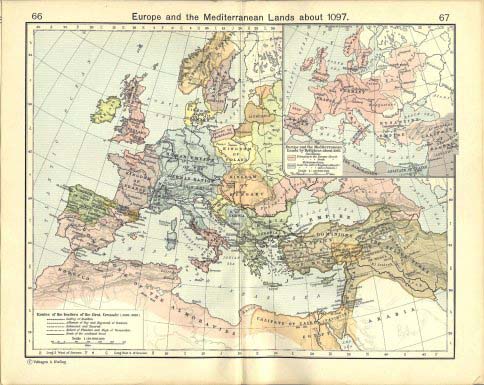
Europe at the end of XIth century.
Summary of the fantastic innovations introduced in Europe between 1000 and 1300. Fundamental dates in humankind mastery of signs, and of production processes.
We saw the fantastic innovations introduced in Europe in the period 1000-1300 (double-entry accounting, bills of exchange, banking). They represent an acceleration of the use of signs. One can distinguish three fundamental dates in the use of signs by humankind:
- the invention of writing in -3000bc,
- the invention of the bill of exchange in the XIIIth century,
- the all-encompassing computerization of human activities in the late XXth century.
Similarly there are three fundamental dates in the mastery of production processes:
- the neolithic agricultural revolution
- the XVIIIth century industrial revolution
- the beginning of the XXIst century
For instance, we should notice that our engines, dating from the industrial revolution (the steam engine followed by the internal combustion engine), are still very rudimentary, even though they lead to the highly abstract science of thermodynamics. The internal combustion engine is based on a gas exploding in a chamber and pushing a piston, a rather crude technique! The XXIst century will, of necessity, introduce much more sophisticated engines possibly inspired by the way Nature transmits energy to plants in the chlorophyll cycle.
Bills of exchange
Payment with gold was cumbersome and risky. The invention of bills of exchange.
The great medieval trade fairs were commercial events where "international" merchants could come and exchange goods produced in their countries of origin. For those merchants who bought more than they sold it required carrying means of payment, that is gold and silver. This was cumbersome, as well as risky, to transport (even though the counts of Champagne provided protection to merchants while they were on their territory). So merchants, helped by bankers, invented the bill of exchange, which is nothing more than a piece of paper acknowledging a debt. But this little piece of paper turns out to be a very important accounting, financial, economic and social device.
An example:
To illustrate how it works, let's take the example (adapted from Bernstein's "The Power of Gold") of four merchants who meet in Troyes in the year 1250:
First transaction (left vertical side of the square below): David, from England, buys wine from Carlo, who comes from Italy. Rather than paying Carlo with gold, David gives him a bill of exchange, that is a piece of paper, signed by David, acknowledging that he has a debt of, say, 10
Venetian ducats to Carlo. In accounting parlance, the bill is drafted by Carlo on David, which is why it is also sometimes called a draft.
Second transaction (right vertical side of the square): Franco, from Italy, buys wool from Berthold who comes from Flanders. Suppose, to keep the example simple, the price is also 10 ducats.
To pay Berthold, Franco will first buy the bill of exchange, drafted on David, that Carlo owns (bottom horizontal side of the square). I.e. Franco will give 10 gold ducats to Carlo in exchange for the bill of exchange (the physical operation of transfering gold could take place in Italy later on). In this operation, Carlo endorses the bill of exchange, that is, he signs it on the back. The meaning of this second signature is that Carlo guarantees to pay the bill of exchange, should David fail to do so.
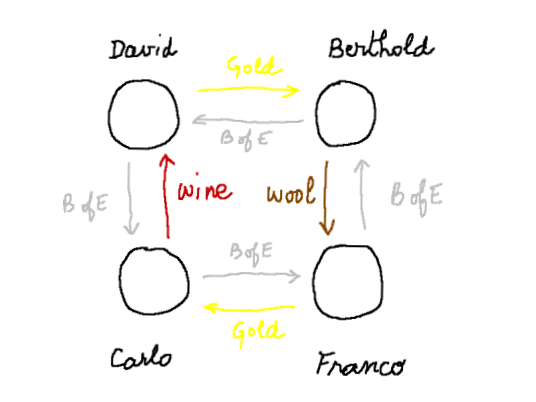
Then Franco uses his bill of exchange (that he, himself, endorses with a third signature, after David and Carlo) to pay Berthold.
Last step (top horizontal side of the square): Berthold presents the bill of exchange, originated by David, to David. In other word he sells back David's bill of exchange to David in exchange for 10 gold ducats. Finally, David finds himself owning his own draft on himself. He can tear it off, because it has no longer any use.
Comments on the example:
- These ways of payment avoided the transportation of gold from Italy and England to Troyes, and then back from Troyes to England and Italy.
- The role of gold as sign was replaced by paper signs.
- It is much less risky and less cumbersome to travel with paper signs than with gold.
- The operation looks trite, and is trite.
- Yet, one would miss a point if he/she thought that there was nothing important and significant in these ways of payment
The first financial securities
These bills of exchange can be viewed as the first financial securities ever invented. (Well I got carried away when I wrote this. In fact all sorts of promises were made in Antiquity and before, that qualify as financial securities.) They are "proto-paper-money". They are private money, in the sense that they are signed by their issuer (and then by whoever endorses them). They only represent value, whereas gold still incorporated the value it represented. Their value depends upon the trustworthiness of their issuer and signatory. It is only a private contract. But it is used to pay, and then it can be transferred to a third agent (Franco), and used again to pay, etc.
After his transaction with Carlo, and before he buys his own bill of exchange back from Berthold, David's balance sheet looks like this:
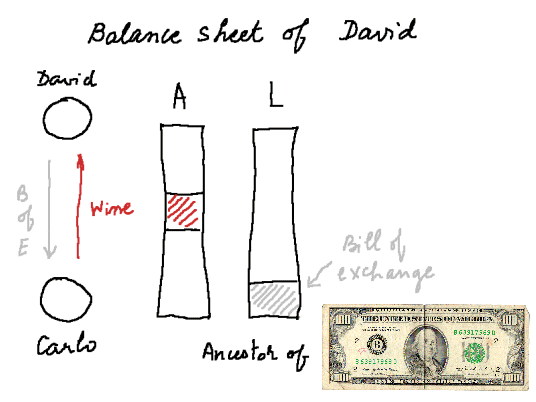
Where is the bill recorded in the buyer and the seller accounting systems
The bill of exchange is recorded in David's book as a credit on the liability side. But physically, it is also a receipt, at first in Carlo's pocket (just like today's bank notes are in my pocket). In other words, it is a paper means of payment held by Carlo. It is a debit in Carlo's books (a financial asset held by Carlo), because Carlo extended credit to David. This debit in Carlo's books happens to be a draft on David, i.e. it is signed by David. Then it goes into Franco's pocket, then Berthold's, who finally sells it back to David.
A hypothesis: it is possible to identify "money" at work in any system of exchange
Money is a medium of exchange that can be material or just signs. In fact it is everywhere, even when these signs are not apparent. It is the case in small communities (a family or a village): there are moneys at work to regulate the participation of each one to the community. But it does not show. Money is even, in other forms, the engine of life: the dynamics of molecules (hydrophobic on one end and
hydrophilic on the other) agglomerating into what becomes the membranes of cells, and these cells exchanging with the exterior, can be
analyzed with models akin to economics and money systems. Cells organizing into organs and bodies follow the same models. And indeed, modern economic systems display an evolution towards clusters and networks. It is a vast field of reflexion and research which we shall not tackle.
Private money and public money: wait another seven centuries
Bills of exchange were invented around the XIIth / XIIIth centuries. As we said, they are only private paper money. Nobody was forced to accept them. In the various European countries public paper money will come only seven centuries later, in the XIXth century, when bank notes issued by one important bank in each country would be made legal tender by the government. The reason why it took such a long time to go from private paper money to public paper money is because strong centralised "absolute monarchies" had to appear first. In the XIIth century they were still incipient (remember feudality, and the conflict between the pope and temporal princes). Absolute monarchies finally triumphed in the XVIth and XVIIth centuries ("la Fronde", in France, was an ultimate tentative by the nobility to restrain the all-domineering power of the king) - only to be toppled shortly afterwards (revolutions of the XVIIth century in England, French revolution in France), but the subsequent regimes kept the centralisation of powers and created, among other institutions, central banks in charge of managing the money. Now, at the beginning of the XXIst century we witness the weakening of the nation-states constructed (in these two stages: monarchies, then centralised parliamentary republics) over the last thousand years.
Before we arrive to the XIXth century, and then to present times and all the rapid financial evolutions of the last 30 years as well as the current ones, we must first turn to early banking.
Banking
Banking is the professional activity of lending monetary means to borrowers
The objective of the borrower is to get help to invest into projects that will allow him/her to produce wealth (and sometimes also just to consume wealth and pay later). And the banker receives a payment for his financial service, usually in the form of interest.
Many other activities of bankers are essentially akin to the above. Among them: lending money in exchange for a bill of exchange held by the borrower; advancing money in the short term; lending money guaranteed by a future harvest or the future proceeds of a trip overseas; exchanging currencies; opening of a line of credit; etc.
Bankers most usually don't buy things, they only lend money or monetary means. Of course lending money is viewed as buying a promise. But the promise specifies that the borrower (= seller = issuer) is under the obligation to refund the loan he received, plus interest, to the banker (= buyer = lender).
In other words, bankers "monetize" value for clients, with guarantees.
Money and religions
In medieval times the catholic church forbade its members to lend money with interest. It is the main reason why this function was fulfilled by Jews. It was also fulfilled by Lombards (which is why many streets in financial districts of big
European cities are called Lombard street), and, after the Reform, by Protestants. To try and explain why these three categories of people were good at banking, one may observe that they were exiles, or like exiles, who must have had a better understanding of immaterial belongings than the
Catholics, who, despite their claims, are notoriously turned towards materiality. And money indeed became a truly powerful medium of exchange when it began to be
dematerialized into signs around the XIIth century.
At first, banking developed as a side activity of big merchant families, like the Bardi, the Peruzzi, or, later on, the Medici, the Fuggers (all of whom began trading in textile products). Indeed, as we saw above with David's balance sheet, the bill of exchange he issued could be used, and was used, as paper money. It was a means of payment held by Carlo, representing a credit to David. Technically we say that it is created by Carlo, drafted on David. Although, it is issued by David, and guaranteed by David. But it requires Carlo's trust. In this example, Carlo acted like the big merchants/bankers of medieval times: it opened a credit to a client, and the paper asset representing the credit became a means of payment on its own.
Over the centuries, banking slowly separated from trading in merchandises, and banks took hold of the business of issuing bank notes used as paper money. In the XIXth century in each currency area one major bank was chosen to become the central bank, with a specific monopoly we shall study later. In England, the Bank Charter Act transforming the Bank of England into the central bank of the sterling zone dates from 1844.
In theory you can start a banking activity if you own a sizeable measure of precious assets, like a quantity of gold coins. In fact, we shall see, even the initial valuable assets may be omitted.
Balance sheet of a banker
The balance sheet of a simple banker who extended one loan looks like this:
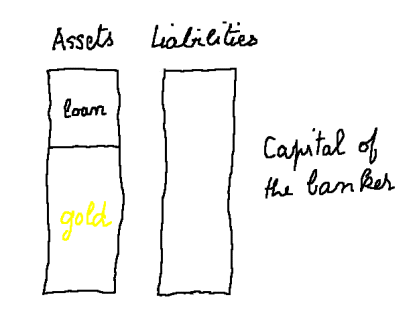
He lent some of his initial assets of gold coins to a borrower. The borrower received the gold coins, and the banker received a piece of paper, signed by the borrower, acknowledging the debt. Later on, at refund time, the banker will receive the gold coins back, plus an interest, in the form of some more gold, which will be recorded in an income statement. And if there is a profit, you will remember from your accounting course that the assets will increase by this profit, and the liabilities too in the profit account on the liability side of the balance sheet.
The first borrowers
The first bankers of the XIIth and XIIIth centuries lent money to kings and knights to wage wars or to go on crusades. The expected interests were simply based on prospective looting.
We see that "accounting" and "finance" are sometimes not much more than formal dressing for invasion, conquest, and force. It hasn't changed much in modern times. The maintaining of sharecroppers in the early XXth century in the South of the United States in a state of perpetual indebtedness is an illustration of this remark.
Banks also redeemed bills of exchange
They also played a role in the system of bills of exchange: they would redeem bills, with an interest. That is they accepted to buy bills of exchange from a merchant and give him gold as a counterpart.
We see that bills of exchange and loans are very similar:
in both cases they are financial securities representing value (guaranteed by the issuer or the borrower).
The trade fair of Medina del Campo
In the late middle ages, the trade fair at Medina del Campo in Spain (140 km north-west of Madrid) dealt mostly with bills of exchange. One could buy or sell these financial securities. It can be viewed as the beginning of financial markets.
Deposits into banks
Bankers, as we know, can also accept deposits (either sight deposits, or time deposits) to increase their assets. In graphic representation it goes like this:
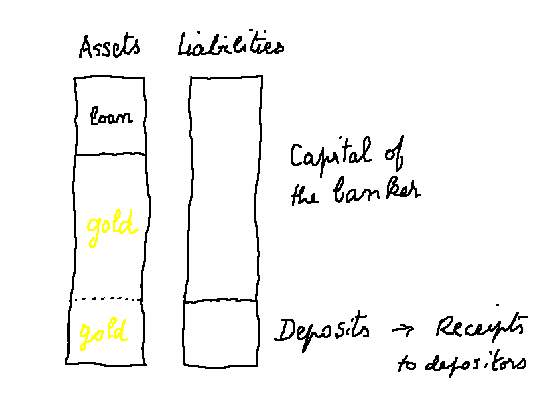
Of course there is no difference, on the assets side, between the gold from the foundation and the gold from the depositors. The dotted line is here only to suggest the increase in assets.
Deposits increase the assets a banker can lend. And they increase its liabilities. How a banker makes a profit.
Now the banker has more assets to lend. The basic source of profit for the banker is that he asks an interest ib from borrowers, and pays an interest id to depositors, and ib > id.
The service fulfilled by the banker, for which he receives his remuneration, consists in selecting the borrowers, managing his assets and liabilities, and helping people with surplus money to make it work.
Bank notes in exchange of deposit
The receipts handed to depositors have a fundamental role in finance. They are also called bank notes. They represent value, since the depositor can, under certain conditions specified when he deposited his gold, get his money back (i.e. his gold back). Therefore they can be used to pay other people in transactions. We shall see shortly how they can become official public money.
Various types of securities already met
In this introductory review of the emergence of money, banking and financial markets, we now have already met three financial securities:
- bills of exchange, issued by merchants
- loans, extended by banks
- bank notes, issued by banks as receipts to depositors
Each of them can be exchanged, traded, bought and sold.
Beware of the vocabulary, which is often used informally
Since the vocabulary may sometimes appear vague, one has to always make sure he/she is clear as to what is the nature of the financial contract (between who and whom) represented by the financial security under consideration.
Another way for a banker to create paper money: bank notes in exchange for a debt (going into the asset side of the banker's balance sheet)
Finally a banker can also produce paper money in another slightly different way. To a new borrower, instead of giving gold in exchange for an IOU acknowledging a debt, he can simply give a bank note. In this case, the bank note no longer corresponds to gold previously brought in by anyone. The graphic representation now is this:
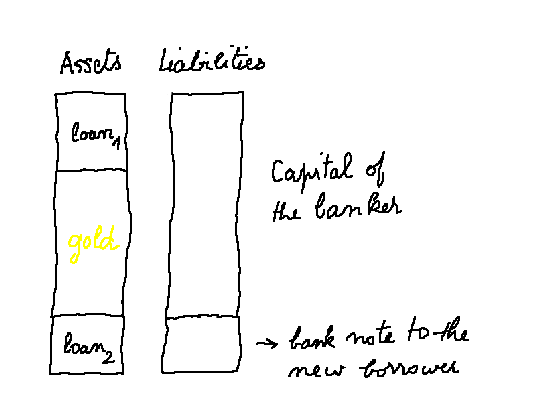
In this case, the banker has created monetary means out of nothing, just like a merchant issued a bill of exchange, which became a tradable financial security, out of nothing.
Notice, though, that the bank note handed out to the new borrower is now guaranteed by the bank. This is an important point: the bank has transformed the pledge of an individual into its own pledge. Inasmuch as the bank is the reunion of its stockholders, now the bank note given to the borrower is guaranteed by all the stockholders. And all the depositors of gold share also the risk.
An apparent paradox
If I keep my one hundred dollar bill in my pocket, nothing happens to it. In one year, at date T, it will still be in my pocket.
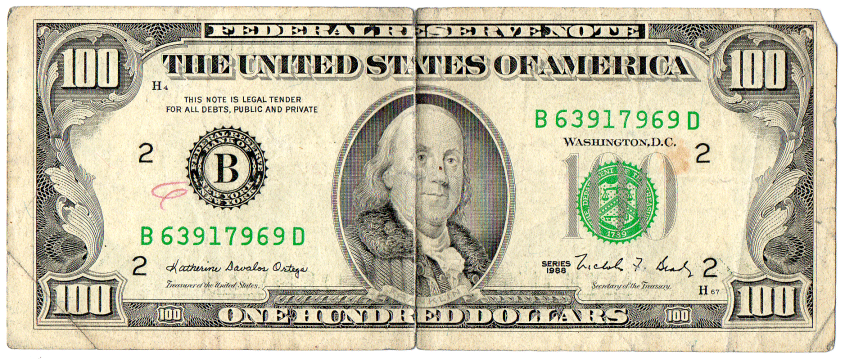
Whereas if today, at date t, I lend it to someone else, in exchange for a one year bond, at date T in one year, if everything goes well, my borrower will pay me back $100 plus some interest, say 5 dollars. Where do the $5 come from?
You learned in your introductory finance course that the present value, at date t, of the future bond payment, discounted with the rate corresponding to the risk of the bond (its so-called opportunity cost of capital), is PV($105) = $100. This is in line with the standard theory of finance (also called Modern Theory of Finance, or MFT), which states that financial investments (as opposed to physical investments) always have NPV = 0.
Furthermore, if I intend to keep the bill in my pocket, in normal economic conditions I lose value, because the present value of the $100-in-one-year is $100 discounted by the risk free rate, something like $98 as of early April 2008. And indeed if I intend to never do anything with my bank note, it is equivalent to not having it, or equivalently of having $0. (Yet to keep the possibility to use it is another more complex story.)
But this does not help much understand the paradox. Once again, where do the $5 come from?
The answer is that our borrower was able to invest the $100 bill in a physical investment which produced value. The borrower produced a positive NPV (which for some reason I could not do myself), and a part of it goes back to me for having lent my dollars.
Well, this clears only a bit the paradox.
In fact the one hundred dollar bill triggered economic exchanges which in turn produced value. The bill passing from hand to hand among various people as a counterpart for exchanges, in the end more wealth was created in the society to which belong these people. (This wealth was consumed or accumulated.) This is where the $5 come from. They are my part of the extra wealth created.
(Here is another closely related apparent paradox generally attributed to J.K. Galbraith.)
It is still true that, of itself, the one hundred dollar bill is not wealth, it is just a sign used by society to set off economic activity. And the beauty of it is that this sophisticated system emerged spontaneously.
Finance does not create wealth, it facilitates the creation of wealth. Only work (and sometimes the variation in desirability of certain things) can create wealth - which after all is morally satisfying. When financial activity is not well controlled it can entail crises like the one the world is going through in early 2008. Everybody hopes it will not spill over to the "real economy" like it did in the 1930's.
More on some paradoxical aspects of banking:
The conventional description of the activity of a bank says that
- it receives money deposits from savers (recorded as a debit entering the balance sheet of the bank, and a credit opened on the liability side), and then
- it can lend this money to borrowers (on the asset side of the balance sheet the cash account balance decresases and a new loan appears that compensates the cash; nothing changes on the liability side).
Secondly, standard textbooks marvel at the fact that banks can create money, since they can perform the second operation above without having received a prior deposit: they just open a loan account on the asset side, and a corresponding account in credit on the liability side.
But a more factual description would just say that the two activities of receiving deposits and of lending money are disconnected. Banks do not "lend the money they received in deposit". What they do is that
- on the one hand, they remunerate deposits (with the exception, usually, of sight deposits) of people who don't use their money, and
- on the other hand, they extend loans - created out of nothing - to people who need money and are creditworthy.
The crux of the matter is that the first view is an old heritage of the times when money incorporated the value it represented. Most people still think of money as something quantitative. It is true very locally (when I give out 2 euros out of the 5 I had in my pocket, I'm left with 3), but not globally.
The modern view of money is that it is not some quantitative measure. It is a certain "degree of liquidity" maintained by the banking system, and any other lenders, in society to help it produce, exchange, and consume. In thermodynamics terms, it is less akin to heat than to temperature.
Confusion created by the evolution from money-matter and to money-sign
The evolution of money from matter to signs (essentially from gold to recordings on pieces of paper or accounting books) is a source of much confusion, because the old ways of thinking are transfered to the new type of money. For instance, when money was only gold (and other precious metals), it made sense to say that a bank lent a part of the gold it had received. But when the money a secondary bank receives is only deposits (recorded on the liability side of its balance sheet) and reserves in the books of the central bank (on the asset side of the balance sheet of the secondary bank, and the liability side of the balance sheet of the central bank), it no longer means the same thing to say that the bank lends some of its deposits. It just respects some ratios between deposits and loans. These are only algebraic signs, with no "material" identity.
The concept of "run" on a bank (everybody, at the same time, asking for his deposited money back) has also changed meaning. At the time of tangible precious metal deposits, it was possible that the bank could no longer hand gold back, but now it is only an accounting phenomenon : the "cash assets" (+ reserves at the central bank) = zero, while the deposits are still in credit. The central bank, however, can create new reserves on its assets and liability sides at will. And this is precisely what the Fed and the ECB did, in very large scale (hundred of billions of dollars and euros) in 2007 and 2008.
To understand that modern money is only a big information system (about rights and liabilities, some private, most of them public), and not a large stash of "quantitative" ("material") money supply circulating in society (the old "token" system), is a fundamental conceptual step that must be taken in order to understand the present financial and monetary world.
The emergence of modern financial and monetary systems
Spontaneous emergence in medieval times, accompanying nominalist thinking
All the financial, banking and monetary operations described so far emerged spontaneously in Europe between the XIIth and the XVIIth centuries. During this period, the various financial securities issued were all private, i.e. guaranteed only by their signatory. The state did not play an active role in managing the banking system. It only, with variable
frequency, debased the money in order to get monetary means, and it borrowed from bankers and other investors, just as it does today.
The rise (and forthcoming fall) of modern nation states
In the course of the XVIIth century it began to be understood by political and social thinkers (William Petty, John Locke, Charles Davenant, etc.), and by authorities, mostly in England and Holland, that to be able to issue paper money was a great social power that should not stay in the hands of private agents. Over the next two centuries (roughly 1650 - 1850), in each western country one main bank emerged (the future central bank), which was eventually granted a monopoly on the issuance of bank notes "useable as money" by everyone in the population. These bank notes were made "legal tenders", that is people could pay any purchase or repay any debt with them, and on the other hand could not refuse them. And it is the unravelling of this process, which accompanied the construction of nation-states over the last three centuries, which we now witness. Thanks to the computer and information treatment revolution of the last 30 years we see new private entities gaining the power to issue the equivalent of private paper money, and nation-states are powerless to control this evolution. It is in fact the beginning of their end, which will be replaced by a new feudality.
The magic faith into convertibility
But these bank notes remained, most of the time, convertible into precious metal (viewed as the only "real money") at the bank that had issued them. It took economists a long time to understand that money is only the system of signs and that "matter doesn't matter", just like it took mathematicians a long time to understand that imaginary numbers (also called complex numbers) are no more imaginary than 1, 2, 3...
John Law experiment in France, at the beginning of the XVIIIth century
The case of France, after the death of Louis XIV, a king who had emptied the Treasury, is special. Between 1716 and 1720, took place the episode of John Law's bank success followed by failure. Beside being some sort of adventurer, John Law was a financial genius, way ahead of his times (see for instance, Edgar Faure, 17 juillet 1720. La banqueroute de Law, Gallimard, 1977). In 1705, at the age of 34, he wrote his first book on money: Money and Trade Considered With a Proposal for Supplying the Nation with Money. A few years later, his recommendation to the Regent to set up, in France, a joint stock company and a bank using paper money (guaranteed by precious metals, land and commercial activities in America) to save the kingdom's finances is a very important event in financial history. Then, at the end of the century, during the French revolution, a second large issuance of paper money, the assignats (guaranteed, this time, by Church assets confiscated by the state in 1789), failed too and disgusted French people for a long time with paper money. This explains why France staid somewhat behind the anglo-saxon world in monetary and financial innovations.
England dominated the world
In the XVIIIth and XIXth centuries, the dominant world power in terms of production, trade, and military might, was England. The main currency worldwide was the pound sterling, convertible into gold (at the famous ratio: one Troy ounce of gold, of 11/12th purity, equals £3 17 shillings and 10½ pence). The pound sterling was "as good as gold".
The Gold standard era
The convertibility of all the important currencies lasted until the end of the gold standard period (c1870 - 1914). Each of them had a fixed exchange rate with gold. For example £100 were equal to 23,54 ounces of pure gold, and $100 = 4,84 oz of pure gold (or equivalently 1oz of gold = $20,67). As a consequence, currencies had fixed exchange rates among each other. For instance, very old people may remember that £1 was equal to $4,86. An economist said that "currencies were only names given to certain weights of gold".
The United States takes the lead
In the XXth century, after 1918 the new dominant world power was the United States. After the
interwar period, which was also a period of great monetary instability, aggravated by the crisis of 1929, the domination of the United States became indisputable.
From Bretton Woods until the definitive end of convertibility
Near the end of WWII, in July 1944, the Bretton Woods agreements set up a new international monetary system, resting on the "solidity of the dollar" (and the economic power of the United States). It was still a system where currencies were convertible into gold, the convertibility being assured in last resort by the US. This convertibility was finally ended, for good, by President Nixon in August 1971.
Floating currencies
Since then, world currencies are no longer guaranteed by any tangible value, they are pure signs, and they "float", in a more or less organized way by central bankers, with respect to each other.
A growing US trade deficit, financed with paper
Meanwhile we have witnessed, since around 1970, the growing trade deficit of the US, which can only end up with the demise of the dollar as the world leading currency.
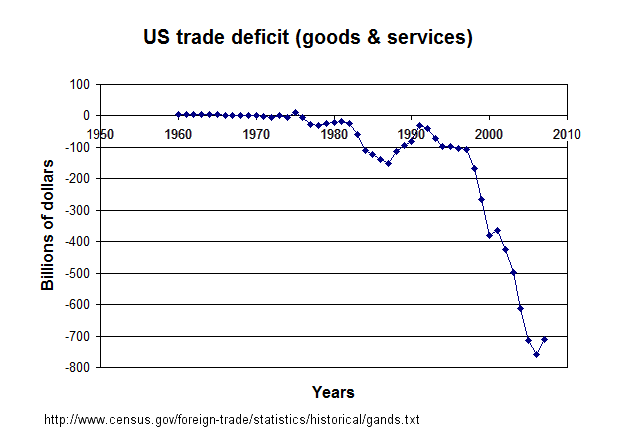
Big changes to come
This review of the emergence of financial products and modern money should
help us better understand the financial evolutions which happened in the world
since 1980, and prepare us for the new evolutions to be expected by anyone lucid. They are momentous, since they will probably include the demise of nation-states as we have known them for the past two hundred years, the likely
emergence of new private moneys and of another world order with new dominant powers (countries and supranational private companies).
One recurrent theme of this course will be the distinction between tangible
value, and financial and monetary signs. Modern money is a vast network of
signs of liabilities between various agents in society, including the whole society
itself. This entails several ideas that are not commonly understood, and are often
mistakenly presented in the press and
on radio and television :
- The burning of a bank note, or of any IOU, is not the destruction of any
tangible value whatsoever; it is only the cancellation of a debt.
- After a brutal stock market downturn, to say that "billions of dollars went up the smokestack" may strike imagination, but is a misleading statement.
- The flow of capital in and out of a country does not correspond to
the naive representation of money like a tide, coming in and staying, or
going out and leaving behind a barren landscape. Unless the two countries have
the same currency, there is always the exchange of hard currency and local
currency. And at any rate, the productive economic forces are there no matter
what. "Capital inflow" only sets them moving with more or less efficiency.
- When the banking system of a country is plagued with bad loans, and is "bailed
out" with large amounts of public money (like happened in Japan, China, and
France over the last twenty years), no tangible value moves; it is only a
redistribution of liabilities among the various agents in society.
- Economic science has not yet clearly explained the link between financial
and monetary phenomena on the one hand, and tangible value creation and
consumption, that is prosperity, on the other hand (sometimes also called "the real economy"). Monetarism (resting on variations on the equation PQ = MV, studied from Cantillon to Friedman) is unconvincing.
It is true that allowing debt creation, to a point spurs economic development
and prosperity, and, reaching excessive levels, hampers it. And it is true
that money is one form of debt, but it is unclear how the financial and
monetary world and the tangible world are linked, and what is the best
financial and monetary system to guarantee prosperity and fairness.
- Most approaches to money are "mechanistic" and "quantitative", but, to use
the jargon of mathematics, money is only locally quantitative.
- Any debt is a "proto-money". Endless discussions as to what precisely
should be included in M3 but not M2 or M1 (various measures of the "money supply")
are as useful as disputes on the sex of angels.
- The role of central banks, since the eighties, has been to "fight inflation". Until the early 2000's, they were reasonably successful, but only at containing the inflation of goods and services, consumed everyday. Western countries have witnessed a tremendous increase in the price of assets, mostly real-estate assets. It is likely to be a consequence of two phenomena: the low inflation of goods and services, the increase in government debts of western countries, which is another way to create money, and therefore depreciate its purchasing power, and create inflation of goods and/or assets.
- Since the Summer of 2007, the Fed and the ECB injected of the order of $1000 billion in order to prevent a collapse of the world financial system with what would be a dramatic series of bankruptcies of financial institutions toppling one another like dominos. This injection of money does not require any particular effort: it is only some accounting entries in the books of the two central banks. The BoE (Bank of England) is joining in the Spring of 2008. But they may unleash the inflation of goods and services, which is now more than negligeable in all western countries: in France, officially, it is around 4% a year, but anyone going to the supermarket knows that, in the Spring of 2008, it is already above 10% from a year ago.
We must keep in mind all these paradoxes when studying financial products.
The next lessons will explain more technically the various financial markets,
products and actors.
Bibliography
Books:
- Marc Levinson,
Guide to Financial Markets, Press of the Economist, 4th edition 2006 (erratum)
- Peter Bernstein, Capital Ideas: The Improbable Origins of Modern Wall Street, Wiley, 1992 (an extension was also published in 2007)
- Frederic Mishkin,
Economics of Money, Banking and Financial Markets, Addison Wesley, 8th edition, 2007
- Paul Wilmott,
Quantitative Finance, Wiley, 2007
- Peter Bernstein,
The Power of Gold, Wiley, 2000
- "Adam Smith" (George Goodman),
Paper Money, Dell 1982
- John C. Hull, Options, Futures and Other Derivatives, Prentice Hall, 6th edition, 2005
- Eric Beinhocker,
The Origin of Wealth, Harvard Business School, 2007
Websites :
-
https://www.pbs.org/wgbh/commandingheights/ on the Thatcher/Reagan revolution and the debate between Hayek and Keynes
-
https://www.hyperhistory.com/online_n2/History_n2/a.html from which the map
below is extracted
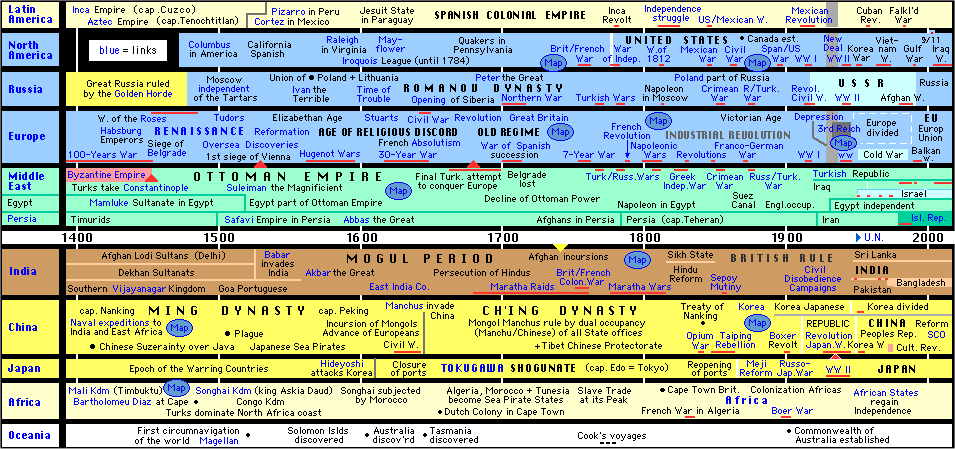
(all the blue links are active on hyperhistory's site, leading to explanatory
texts or to maps)
Documents
Go to lesson 2
|
